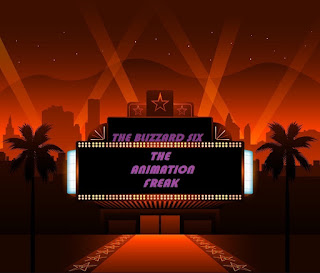The Animation Freak. Alice in Wonderland.
The Animation Freak.
Alice in Wonderland.
In a park in England, a young girl named Alice with her cat, Dinah, listens distractedly to her sister's history lesson, and begins daydreaming of a nonsensical world. She spots a passing White Rabbit in a waistcoat, who panics of being late. Alice follows him into a burrow and plummets down a deep rabbit hole. Upon landing in a place called Wonderland, she finds herself facing a tiny door, whose handle advises drinking from a bottle on a nearby table. She shrinks to an appropriate height, but has forgotten the key on the table. She then eats a cookie that causes her to grow excessively. Exasperated by these changes of state, she begins to cry and floods the room with her tears. She takes another sip from the bottle to shrink again, and rides the empty bottle through the keyhole. As Alice continues to follow the Rabbit after encountering a “Cacaus Race”, she encounters numerous characters, including Tweedledum and Tweedledee, who recount the tale of "The Walrus and the Carpenter". Alice tracks the Rabbit to his house; he mistakes her for his housemaid, "Mary Ann", and sends her inside to retrieve his gloves. While searching for the gloves, Alice finds and eats another cookie and grows giant, getting stuck in the house. Thinking her a monster, the Rabbit asks the Dodo to help expel her. When the Dodo decides to burn the house down, Alice escapes by eating a carrot from the Rabbit's garden, which causes her to shrink to 3 inches tall.
Continuing to follow the Rabbit, Alice meets a garden of talking flowers who initially welcome her with a song, but then banish her, believing that humans are a type of weed. Alice then encounters a Caterpillar smoking, who becomes enraged at Alice after she laments her small size (which is the same as the Caterpillar's), after which the Caterpillar turns into a butterfly and flies away. Before leaving, the Caterpillar advises Alice to eat a piece from different sides of a mushroom to alter her size. Following a period of trial and error, she returns to her original height and keeps the remaining pieces in her pocket. In the woods, Alice gets stuck between multiple paths and encounters the mischievous Cheshire Cat, who suggests questioning the Mad Hatter or the March Hare to learn the Rabbit's location, but is unhelpful in giving directions. Taking her own path, Alice encounters both, along with the Dormouse, in the midst of an "unbirthday" tea party celebration. The Hatter and the Hare ask Alice to explain her predicament, to which Alice tries but becomes frustrated by their interruptions and absurd logic. As she prepares to leave, the Rabbit appears and the Hatter attempts to repair his pocket watch, which results in its destruction. Alice attempts to follow the Rabbit after he is ejected from the premises, but decides to go home instead. Unfortunately, her surroundings completely change, leaving her lost in the forest.
The Cheshire Cat reappears to the despondent Alice and offers a path to the hot-headed Queen of Hearts, the only one who can take her home. In the Queen's labyrinthine garden, Alice witnesses the Queen – whom the Rabbit serves as a chamberlain – sentencing a trio of playing cards to execution for painting mistakenly-planted white rosebushes red. The Queen invites a reluctant Alice to play against her in a croquet match, in which live flamingos, card guards, and hedgehogs are used as equipment. The equipment rig the game in favor of the Queen. The Cat appears again and plays a trick on the Queen, setting up Alice to be framed. Before the Queen can order her execution, the King suggests a formal trial. At Alice's trial, the Cat invokes more chaos by having Alice point him out, causing one of the witnesses – the Dormouse – to panic. As the Queen orders Alice's execution, Alice eats the mushroom pieces to grow large, momentarily intimidating the court. However, the mushroom's effect is short-lived, forcing Alice to flee through the deteriorating realm with a large crowd in pursuit. When Alice reaches the small door she encountered, she sees herself sleeping through the keyhole. Alice emerges from her dream, and she returns home for tea with her sister.
Walt Disney was familiar with Lewis Carroll's Alice books, Alice's Adventures in Wonderland (1865) and Through the Looking-Glass (1871), and had read them as a school boy.
In 1923, he was a 21-year-old aspiring filmmaker working at the Laugh-O-Gram Studio in Kansas City, making the unsuccessful short cartoon series by the name of Newman Laugh-O-Grams. The last of Newman Laugh-O-Grams was called Alice's Wonderland, which was loosely inspired by the Alice books. The short featured a live-action girl (Virginia Davis) interacting with an animated world. Faced with business problems, however, the Laugh-O-Gram Studio went bankrupt in July 1923, and the film was never released to the general public. However, Disney left for Hollywood and used the film to show to potential distributors. Margaret J. Winkler of Winkler Pictures agreed to distribute the Alice Comedies, and Disney partnered with his older brother Roy O. Disney and re-hired Kansas City co-workers including Ub Iwerks, Rudolph Ising, Friz Freleng, Carman Maxwell and Hugh Harman to form the Disney Brothers Studios, which was later re-branded Walt Disney Productions. The series began in 1924 before being retired in 1927.
In 1933, Disney considered making a feature-length animated-and-live-action version of Alice starring Mary Pickford. However, these plans were eventually scrapped in favor of Snow White and the Seven Dwarfs, mainly because Disney was put off by Paramount's 1933 live-action adaptation Alice in Wonderland. However, Disney did not completely abandon the idea of adapting Alice, and in 1936 he made the Mickey Mouse cartoon Thru the Mirror.
In 1938, after the enormous success of Snow White, Disney bought the film rights of Alice in Wonderland with Sir John Tenniel's illustrations, and officially registered the title with the Motion Picture Association of America. He then hired storyboard artist Al Perkins and art director David S. Hall to develop the story and concept art for the film. A story reel was completed in 1939, but Disney was not pleased; he felt that Hall's drawings resembled Tenniel's drawings too closely, making them too difficult to animate, and that the overall tone of Perkins' script was too grotesque and dark. Realizing the amount of work needed for Alice in Wonderland, and with the economic devastation of World War II and the production demands of Pinocchio, Fantasia, and Bambi, Disney shelved production on Alice in Wonderland shortly after the screening.
In fall 1945, shortly after the war ended, Disney revived Alice in Wonderland and hired British author Aldous Huxley to re-write the script. Huxley devised a story in which Lewis Carroll and Alice Liddell (the inspiration for Alice) were misunderstood and persecuted following the book's publication. In Huxley's story, stage actress Ellen Terry was sympathetic to both Carroll and Liddell, and Queen Victoria served as the deus ex machina, validating Carroll due to her appreciation for the book. Disney considered child actress Margaret O'Brien for the title role. However, he felt that Huxley's version was too literal an adaptation of Carroll's book. Background artist Mary Blair submitted some concept drawings for Alice in Wonderland. Blair's paintings moved away from Tenniel's detailed illustrations by taking a modernist stance, using bold and unreal colors. Walt liked Blair's designs, and the script was re-written to focus on comedy, music, and the whimsical side of Carroll's books.
Around this time, Disney considered making a live-action-and-animated version of Alice in Wonderland (similar to his short Alice Comedies) that would star Ginger Rogers and would utilize the recently developed sodium vapor process. Lisa Davis (who later voiced Anita Radcliffe in One Hundred and One Dalmatians) and Luana Patten were also considered for the role of Alice. However, Disney soon realized that he could only do justice to the book by making an all-animated feature and, in 1946, work began on Alice in Wonderland. With the film tentatively scheduled for release in 1950, animation crews on Alice in Wonderland and Cinderella effectively competed against each other to see which film would finish first. By early 1948, Cinderella had progressed further than Alice in Wonderland.
A legal dispute with Dallas Bower's 1949 film version was also under way. Disney sued to prevent release of the British version in the U.S., and the case was extensively covered in Time magazine. The company that released the British version accused Disney of trying to exploit their film by releasing its version at virtually the same time.[
Through various drafts of the script, many sequences that were present in Carroll's book drifted in and out of the story. However, Disney insisted that the scenes themselves keep close to those in the novel since most of its humor is in the writing.
One omitted scene from the 1939 treatment of the film occurred outside the Duchess' manor, where the Fish Footman is giving a message to the Frog Footman to take to the Duchess, saying that she is invited to play croquet with the Queen of Hearts. Alice overhears this and sneaks into the kitchen of the manor, where she finds the Duchess' Cook maniacally cooking and the Duchess nursing her baby. The cook is spraying pepper all over the room, causing the Duchess and Alice to sneeze and the baby to cry. After a quick conversation between Alice and the Duchess, the hot-tempered Cook starts throwing pots and pans at the noisy baby. Alice rescues the baby, but as she leaves the house the baby turns into a pig and runs away. The scene was scrapped for pacing reasons.
Another scene that was deleted from a later draft occurred in Tulgey Wood, where Alice encountered what appeared to be a sinister-looking Jabberwock hiding in the dark, before revealing himself as a comical-looking dragon-like beast with bells and factory whistles on his head. A song, "Beware the Jabberwock", was also written. However, the scene was scrapped in favor of The Walrus and the Carpenter poem. Out of a desire to keep the Jabberwocky poem in the film, it was made to replace an original song for the Cheshire Cat, "I'm Odd".
Another deleted scene in Tulgey Wood shows Alice consulting with The White Knight, who was meant to be somewhat a caricature of Walt Disney. Although Disney liked the scene, he felt it was better if Alice learned her lesson by herself, hence the song "Very Good Advice".
Other characters, such as The Mock Turtle and the Gryphon were discarded for pacing reasons.





Comments
Post a Comment